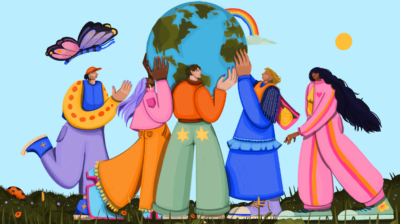Quiz: How much do you know about fast fashion?
Take this quiz to see how much you know about fast fashion and how to make more sustainable choices

Fast fashion is one of the most profitable industries in the world – but it is also one of the most environmentally damaging. People are becoming more aware of the impact that our wardrobes can have on the planet, and the changes that need to happen to create a more environmentally friendly fashion industry.
Take our quiz to see how much you know about fast fashion.
How can you tell if something is ‘fast fashion’?
Fast fashion refers to online and high street stores that sell clothes with a constantly rotating range of styles, colours and trends. The clothes are usually (but not always) cheap. They are often made using synthetic fibres like polyester or nylon, and are not made to last. Learn more about fast fashion here.
The main reason clothes are so cheap in fast fashion stores is because…
The reason clothes are so cheap in high street shops and on many online stores is because the people who make the clothes are paid very low wages (around €2 a day in some cases) and are often exploited, forced to work long hours in poor conditions. Learn more about how the clothes we buy impacts on the people making them.
Greenwashing is when…
Greenwashing is a marketing technique used by companies to give the impression that their products, practices and policies are more environmentally-friendly than they actually are. They trick people who are trying to make more sustainable choices into buying their products, allowing them to make more money while doing little to benefit the environment - and in some cases, continuing to harm the environment. Learn more about greenwashing.
True or False: Sustainable fashion is always expensive
Many people feel sustainable fashion is not accessible to them because it costs too much - but there are ways to create a more sustainable wardrobe without spending a lot of money. This includes choosing secondhand, wearing what you already own, repairing and upcycling clothes, and giving any item of clothing you do buy as long a life as possible. Learn more about sustainable fashion on a budget.
Which of the following materials are made using plastic?
Synthetic fibres like nylon, polyester and lycra are actually made from plastic. This means these fibres can actually be toxic for the environment, and often take much longer to biodegrade which means if you throw away an item of clothing made from synthetic material, it could sit in a landfill for a long time to come. Learn more about the materials our clothes are made from.
True or False: Cotton is always the more sustainable option
Although cotton may seem like the better choice because it’s made from natural fibres, growing and manufacturing cotton requires a large amount of water, chemicals and pesticides. However, to reduce the impact you can look for clothes made with certified organic cotton, which removes harmful pesticides and chemicals from the process, or recycled cotton which is one of the more sustainable materials available, because it repurposes old cotton textile waste. Learn more about sustainable materials.
What is the best way to create a more sustainable wardrobe?
One of the most effective things you can do to reduce the impact of your wardrobe on the planet is to buy less. Often, we have clothes in our wardrobe that we’ve forgotten about entirely, or there are items you could repair or use in a different way. Of course, sometimes we need to buy clothes, and that’s okay - making the effort to reduce the amount of clothes we do buy is a good first step. Learn more about making more sustainable clothing choices.
Which of the following materials can result in microplastics in waterways after washing?
Clothes made of synthetic materials like polyester release tiny particles called microplastics when you wash them. Washing synthetic clothes is responsible for 35% of microplastics in our environment. These microplastics can pollute waterways and end up in our food when they get eaten by the animals we consume. It’s okay if you own things made of synthetic materials, but washing them less can help minimize their impact on the environment. Learn more about the impact of our clothing materials on the environment.
In order to tackle fast fashion, we need to see companies changing their practices and governments introducing regulations. However, some changes we can make in our own lives include:
The responsibility for changing the fast fashion industry lies with the people who sell us our clothes. It also lies with local and national Governments and international bodies like the EU who can introduce laws and tighter regulations to force those companies to change their practices. However, there are also positive steps we can make in our own lives to reduce the impact of our clothes on the planet. This is something we can all call for - learn more about becoming active in sustainable fashion.






